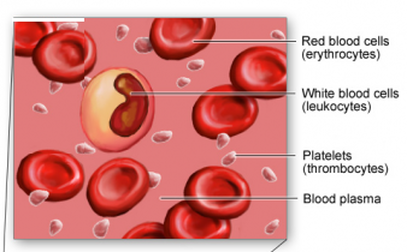Blood
Structure and Function of Blood Vessels
Our blood vessels are essential as it carries blood around the body. They allow blood to circulate around the body as it contains useful substance such as oxygen and nutrients. It also removes waste products from the cells so that they can be taken away to be excreted.
| Blood Vessel | Structure | Function |
| Arteries | Thick walls containing lots of muscles (makes it strong) and elastic fibres (makes it stretch). Small lumen | Almost all arteries carry oxygenated blood which high pressure away from the heart. Pulmonary artery is the only artery that carries deoxygenated blood from the heart to the lungs. |
| Veins | Thin walls with less muscle and elastic fibres. Large lumen Contains one-way valves to prevent blood from flowing backwards. | Carry deoxygenated blood (with low pressure) from tissues back to the heart The pulmonary vein is the only vein that carries oxygenated blood from the lungs to the heart. |
| Capillaries | Thin walls that are one cell thick (less of a distance for substances to diffuse across) | Connects arteries to veins - site of exchange between blood and body tissues. Allows food and oxygen to diffuse between blood and cells. The blood that flows through has low pressure |
Calculating Bloodflow
Heart rate, stroke volume and cardiac output can be calculated with the following equation:
cardiac output = stroke volume × heart rate
Cardiac output is the amount of blood that can be pumped by the heart per minute.
Heart rate is the most useful indicator of whether the heart is functioning normally. The more exercise you do, the higher the heart rate is so that more blood can be pumped around the body, so that the right molecules can be transported to the blood.
Structure and Function of Blood Cells
Blood is made of cells that float around in the plasma. The majority of the blood cells are red blood cells, and there are small numbers of white blood cells. Only a small number of platelets can be found in the bone marrow.
| Blood Cell | Structure | Function |
| Red Blood Cells (Erythrocytes) | Cytoplasm contains haemoglobin. Biconcave disc shape with no nucleus to maximise the gas exchange | Transports Oxygen from lungs to all respiring tissues. Haemoglobin carries oxygen |
| White Blood cells (phagocytes and lymphocytes) | Has a nucleus which is quite large. It can move around and fit into walls of blood capillaries. | Fighting pathogens and clearing dead body cells. Phagocytes engulf and digest microorganisms that may cause an infection. Lymphocytes create antibodies that tackle antigens, and they attack foreign/infect cells. |
| Plasma | Liquid substance | Carries blood cells |
| Platelets (thrombocytes) | Made of cell fragments | Helps blood clot to take place |
Treating Cardivascular Diseases
In coronary heart disease layers of fatty material build up inside the coronary arteries, narrowing them. This reduces the flow of blood through the coronary arteries, resulting in a lack of oxygen for the heart muscle.
| Treatment | Advantages | Disadvantages |
| Drugs (e.g. Statin) |
|
|
| Mechanical Devices |
|
|
| Transplant |
|
|
In some people heart valves may become faulty, preventing the valve from opening fully, or the heart valve might develop a leak. Faulty heart valves can be replaced using biological or mechanical valves.
- What is the name of the drug that patients with cardiovascular take, and it reduces the blood cholesterol levels?
- Statins
- Describe the adaptation of a red blood cell.
- Your answer should include: Biconcave / Disc / Shape / No / Nucleus / Maximise / Amount / Gas / Exchange

